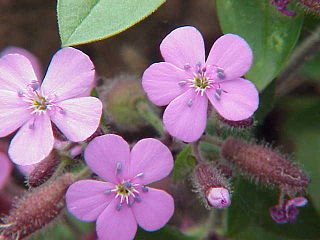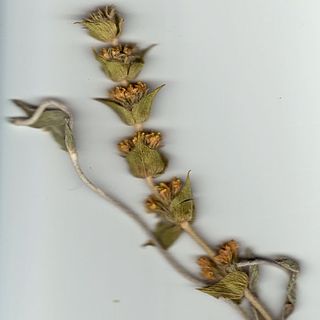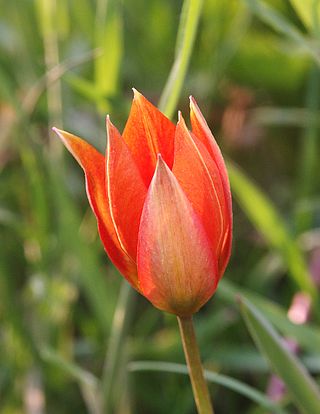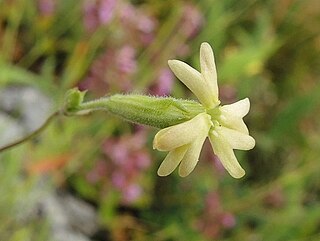
Colchicum is a genus of perennial flowering plants containing around 160 species which grow from bulb-like corms. It is a member of the botanical family Colchicaceae, and is native to West Asia, Europe, parts of the Mediterranean coast, down the East African coast to South Africa and the Western Cape. In this genus, the ovary of the flower is underground. As a consequence, the styles are extremely long in proportion, often more than 10 cm (4 in). All species in the genus are toxic.

Verbascum is a genus of over 450 species of flowering plants, common name mullein, in the figwort family Scrophulariaceae. They are native to Europe and Asia, with the highest species diversity in the Mediterranean.

Saponaria is a genus of flowering plants in the family Caryophyllaceae, native to Asia and Europe, and are commonly known as soapworts. They are herbaceous perennials and annuals, some with woody bases. The flowers are abundant, five-petalled and usually in shades of pink or white. The genus is closely related to the genus Silene, being distinguished from these by having only two styles in the flower. It is also related to Gypsophila, but its calyx is cylindrical rather than bell-shaped.

Anthemis is a genus of aromatic flowering plants in the family Asteraceae, closely related to Chamaemelum, and like that genus, known by the common name chamomile; some species are also called dog-fennel or mayweed. Anthemis are native to the Mediterranean region and southwest Asia east to Iran. A number of species have also become naturalized in the United Kingdom and other parts of the world.

Aethionema is a genus of flowering plants within the family Brassicaceae. They are known as stonecresses. Stonecresses originate from sunny limestone mountainsides in Europe and West Asia, especially Turkey.

Scilla luciliae is a species of flowering plant in the family Asparagaceae. It is referred to by the common names Bossier's glory-of-the-snow or Lucile's glory-of-the-snow, and is a bulbous perennial from western Turkey that flowers in early spring. After flowering, it goes into dormancy until the next spring. The specific epithet is in honour of Lucile, the wife of the Swiss botanist Pierre Edmond Boissier (1810-1885). It belongs to a group of Scilla species that were formerly put in a separate genus, Chionodoxa, and may now be treated as Scilla sect. Chionodoxa.

Sideritis, also known as ironwort, mountain tea, Greek tea and shepherd's tea, is a genus of flowering plants known for their use as herbal medicine, commonly as a herbal tea. They are abundant in Mediterranean regions, the Balkans, the Iberian Peninsula and Macaronesia, but can also be found in Central Europe and temperate Asia.

Dactylis glomerata is a species of flowering plant in the grass family Poaceae, known as cock's-foot, also colloquially as orchard grass, or cat grass (due to its popularity for use with domestic cats). It is a cool-season perennial C3 tufted grass native throughout most of Europe, temperate Asia, and northern Africa.
Umbilicus chloranthus is a species of flowering plant in the Crassulaceae family. It is referred to by the common names green Venus' navel and ombelico di Venere verdastro. It is native to Albania, the East Aegean Islands, Greece, Turkey, and Yugoslavia.
Adonis cyllenea is a species of flowering plant in the family Ranunculaceae. It is endemic to Greece.
Melica rectiflora is a species of grass in the family Poaceae. It is native to Greece and Crete.
Allium frigidum is a species of flowering plant in the family Amaryllidaceae. It is endemic to Greece.
Gagea amblyopetala is a Eurasian species of plants in the lily family, Liliaceae. It is native to the Aegean Islands, Albania, Crete, Crimea, Greece, Italy, Sicily, Turkey, Yugoslavia. It is a bulb-forming perennial with yellow flowers.

Quercus vulcanica is a species of flowering plant in the Fagaceae family. It is referred to by the common name Kasnak oak, and is a rare species of tree native to Lebanon, Syria, and Turkey. It is placed in section Quercus.

Iris attica, the Greek iris, is a plant species in the genus Iris, it is also in the subgenus Iris. It is a rhizomatous perennial, from the mountains of the Balkans in Europe, within the countries of Greece, former Yugoslavia, Turkey and North Macedonia. It has sage green or grey-green leaves, that are sickle-shaped, a stout short stem and 2 variable flowers, in shades from yellow to purple. They have a white or blue beard. It is often called Iris pumila subsp attica, but is classified in most sources, as a separate species, although it is closely related to Iris pumila, as a possible parent plant. It is cultivated as an ornamental plant in temperate regions.

Tulipa orphanidea is a species of flowering plant in the Liliaceae family. It was described by Pierre Edmond Boissier and Theodor Heinrich Hermann von Heldreich (1862).

Aethionema grandiflorum, commonly known as Persian stonecress or Persian candytuft, is a flowering plant in the family Brassicaceae, preferring to grow at 750 to 2600 m on limestone slopes. It is sometimes kept as a garden plant, and occasionally naturalizes outside its original range of eastern Turkey, the southern Caucasus and northern Iran. It is a recipient of the RHS's Award of Garden Merit.

Silene flavescens is a species of flowering plant part of the genus Silene, family Caryophyllaceae. It is native to the Balkan Peninsula and Hungary. It is an herbaceous species belonging to the tribe Sileneae.
Beta nana, the dwarf beet, is a species of flowering perennial plant in the family Amaranthaceae endemic to the mountains of central and southern Greece.

Arum creticum, the Cretan arum, is a species in of flowering plant in the family Araceae. It is native to the Greek island of Crete (Kriti), the Eastern Aegean Islands, and southwestern Turkey. This semi-evergreen clump-forming tuberous perennial has large arrow-shaped leaves. Erect folded-back spathes of fragrant yellow or cream appear in spring, with longer narrow spadices of a darker yellow. The flowers are followed in autumn by clusters of red or orange fruit. The plant reaches 50 cm (20 in) tall and broad.












